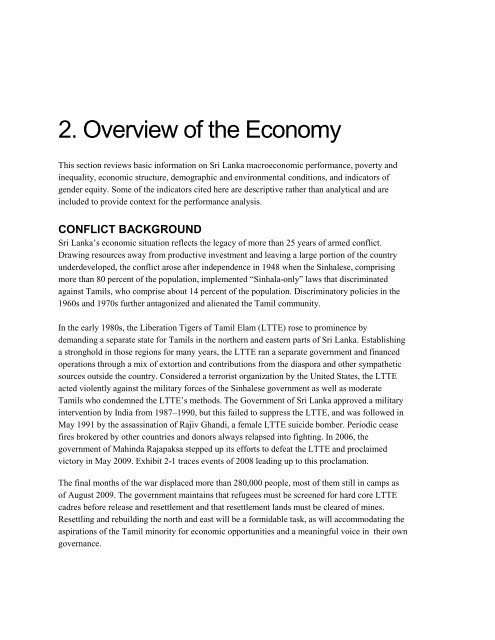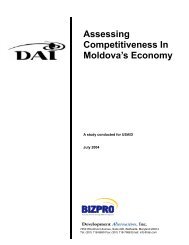Sri Lanka Economic Performance Assessment (2009)
Sri Lanka Economic Performance Assessment (2009)
Sri Lanka Economic Performance Assessment (2009)
You also want an ePaper? Increase the reach of your titles
YUMPU automatically turns print PDFs into web optimized ePapers that Google loves.
2. Overview of the Economy<br />
This section reviews basic information on <strong>Sri</strong> <strong>Lanka</strong> macroeconomic performance, poverty and<br />
inequality, economic structure, demographic and environmental conditions, and indicators of<br />
gender equity. Some of the indicators cited here are descriptive rather than analytical and are<br />
included to provide context for the performance analysis.<br />
CONFLICT BACKGROUND<br />
<strong>Sri</strong> <strong>Lanka</strong>’s economic situation reflects the legacy of more than 25 years of armed conflict.<br />
Drawing resources away from productive investment and leaving a large portion of the country<br />
underdeveloped, the conflict arose after independence in 1948 when the Sinhalese, comprising<br />
more than 80 percent of the population, implemented “Sinhala-only” laws that discriminated<br />
against Tamils, who comprise about 14 percent of the population. Discriminatory policies in the<br />
1960s and 1970s further antagonized and alienated the Tamil community.<br />
In the early 1980s, the Liberation Tigers of Tamil Elam (LTTE) rose to prominence by<br />
demanding a separate state for Tamils in the northern and eastern parts of <strong>Sri</strong> <strong>Lanka</strong>. Establishing<br />
a stronghold in those regions for many years, the LTTE ran a separate government and financed<br />
operations through a mix of extortion and contributions from the diaspora and other sympathetic<br />
sources outside the country. Considered a terrorist organization by the United States, the LTTE<br />
acted violently against the military forces of the Sinhalese government as well as moderate<br />
Tamils who condemned the LTTE’s methods. The Government of <strong>Sri</strong> <strong>Lanka</strong> approved a military<br />
intervention by India from 1987–1990, but this failed to suppress the LTTE, and was followed in<br />
May 1991 by the assassination of Rajiv Ghandi, a female LTTE suicide bomber. Periodic cease<br />
fires brokered by other countries and donors always relapsed into fighting. In 2006, the<br />
government of Mahinda Rajapaksa stepped up its efforts to defeat the LTTE and proclaimed<br />
victory in May <strong>2009</strong>. Exhibit 2-1 traces events of 2008 leading up to this proclamation.<br />
The final months of the war displaced more than 280,000 people, most of them still in camps as<br />
of August <strong>2009</strong>. The government maintains that refugees must be screened for hard core LTTE<br />
cadres before release and resettlement and that resettlement lands must be cleared of mines.<br />
Resettling and rebuilding the north and east will be a formidable task, as will accommodating the<br />
aspirations of the Tamil minority for economic opportunities and a meaningful voice in their own<br />
governance.
















